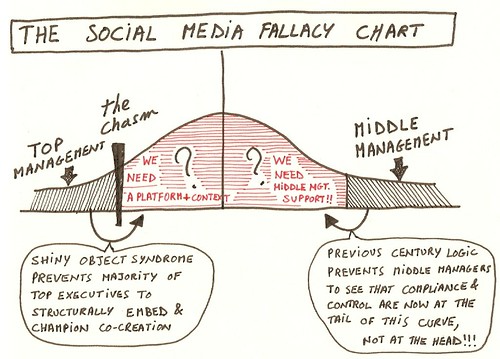Social networks are changing the laws of gravity for our organizations. For middle management this means that the ceiling they are pushing against turns out to be the carpet on the floor.
This is the fourth consecutive night that I am trying to cram my thoughts into an article. Never happened over the past four years of blogging. I consider that a sign. Here we go: the Thursday night post that I wanted to get out of my system since last Sunday…
I am in my late thirties and if I would have chosen for a fixed employment I would probably be in a middle management position, i.e.: accountable for a business unit or a brand and managing a team or a department. I would be pushing the ceiling of promotion to make sure I’d anchor myself onto ‘a decent level’ by the time I am forty.
Rat Race for Compliance
Don’t get me wrong; I have a tremendous respect for middle managers, but I don’t envy them. I can’t help feeling sorry when I see how they are locked-up in the rat race. Their destiny is shaped by corporate culture and an ‘up-or-out’ regime where KPI’s and budgets tell you exactly how high you need to jump. And in case one would doubt, there are always HR performance appraisal systems to add an extra layer of behavioral conditioning.
Sure, these people are paid well and they have a hell of a responsibility. This is what makes machines out of middle managers. They have no other choice than to fit into the game that was invented by Henri Fayol. The game consists of five layers, which are also known as ‘management’. They are:
- plan (and look ahead),
- organize,
- command,
- co-ordinate,
- control (feedback and inspect)
For more than 120 years this was the management model that made great companies. Unfortunately, the way we run our companies and push middle managers is based on this same 120 year old logic. In an earlier article I have argued what this comes down to: since information is no longer scarce, compliance is no longer the shortest path to productivity. Productivity nowadays is about how you can make a connection to customers, suppliers and other stakeholders.
Isolating the Problem
In pretty much the same way as the internet has reshaped the supply side of our economy, social networks are reshaping the demand side. The same dynamics that have made information abundant have made it easier to connect with customers. Social media platforms such as Facebook, Twitter, LinkedIn, blogs, wiki’s, etc. have taught us a new form of interacting. Control is no longer the center of gravity; co-creation is.
So here is a double problem:
- When the rules of the game change, the way to get to your destination changes as well. Imagine what it would feel like when you are a middle manager and you are almost breaking though the glass ceiling. Then, all of a sudden it turns out to be the carpet on the floor?
- In this changed game, middle management is still conditioned into compliance-mode by top managers who – ironically enough – are jumping from one fad to the other, making even more dust in the social media arena because they are smelling money. Unfortunately, their budgets are bigger than their attention span and their grasp of what co-creation really is about: the ‘being with’ a shop-floor problem for example.
The End of Middle Management?
A few months ago Harvard professor Lynda Gratton announced the end of middle management. According to her the technological revolution will make the need for middle management obsolete. There are four main reasons for her to believe that the disappearance is on the cards:
- Technology has become the great general manager.
- Skilled team members are increasingly self-managed.
- Attitudes toward management have also changed.
- The management of virtual teams takes extreme specialist skills.
When the Dust has Settled
Those of us who have been around long enough may react by saying that we are in the middle of yet another trend. We have seen entire industries shift towards, TQM (Total Quality Management), BPR (Business Process Reengineering), CRM (Customer Relationship Management), etc. and every time the dust settles we see that the good old laws of gravity still apply: work hard to get things done.
The question is what will remain once the dust has settled over social networks? It is still too early to say, but I suspect that some things will have changed. Here is what I suspect that will happen:
- Middle Management will still exist (sorry Lynda)
- The role of Middle Management will however shift completely from a “tool for compliance” into a “partner for co-creation”
- The only way to make this shift happen is by declaring and installing a social architecture, i.e.: a platform on top of your hierarchy that allows for co-creation.
A Call to Action
So middle managers have no fear, your job will not disappear. To the contrary, you should rejoice at the new roles you will be getting and therefore it is time to let go of your fear of social networks. Also: stop telling your colleagues that social networks are a danger for productivity, because they are becoming tools of productivity as we speak.
Just remember that productivity is no longer solely defined by compliance (this has become the lower threshold) but by co-creation (the carpet has now become the ceiling).




Pingback: The Impact of Social Media on Doing Business | Reply-MC()
Pingback: The Clash of Authority and Influence | Reply-MC()